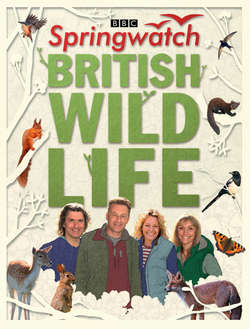Читать книгу Springwatch British Wildlife: Accompanies the BBC 2 TV series - Stephen Moss - Страница 14
ОглавлениеNuthatch & Treecreeper
©Paul Sawer/FLPA
Treecreepers sing their high-pitched, delicate song from early spring onwards.
These two characteristic birds of woods and forests are easy to overlook, yet fascinating in their habits. Apart from the woodpeckers, no other pair of birds has adapted so well to their tree-loving lifestyle.
Finding either of them can take time and patience, but it is certainly better to sit and wait, rather than walk around, as you are searching for movement, which is always much easier to notice if you are still. Listening is also helpful. Both species have distinct calls: the nuthatch has a rather loud and penetrating ‘too-it’, while the treecreeper utters a very high-pitched call, which can be confused with that of another small woodland bird, the goldcrest.
If you get a good view of a nuthatch, you simply cannot mistake it for any other bird. It is about the size of a great tit, but plumper and more potbellied in shape, with gunmetal-blue upper parts and orange under parts, a long, dagger-like bill and a really distinctive black ‘highwayman’s mask’. It also has the unique skill among British birds of being able to climb down a tree trunk as well as up, which is very useful when you live in a world of vertical trunks and horizontal branches.
The treecreeper is a smaller bird, much more modest in its appearance and habits. Basically, it is brown above and white below, but you are much more likely to identify it by its habits than by its plumage. It behaves rather like a small rodent, climbing up and around the trunks of trees before flying off to the next one, thus revealing that it is a bird and not a small mammal. If you get good views, you will see its thin, decurved bill – perfect for prising tiny insects out of the crevices of the bark in which they may be hiding.
Treecreepers are found throughout Britain and Ireland, whereas the nuthatch is confined mainly to England and Wales, though a few have now spread northwards to breed in southern Scotland. With climate change, nuthatches may continue to extend their range northwards in the coming decades, but they are a very sedentary bird, unable to cross large stretches of water, which explains why they are not found in Ireland.
Like most other woodland birds, the nuthatch and the treecreeper nest in holes or crevices in trees, but whereas the nuthatch usually chooses an old woodpecker hole, which it often makes smaller by patching it up with mud, the treecreeper prefers to nest in a narrow crack or even beneath a piece of loose bark. Both will readily take to nest boxes, the nuthatch in the usual ‘tit box’, and the treecreeper in a specially designed, wedge-shaped version, rather like a bat box in shape.
In the autumn and winter months, they will often join forces with other small birds, such as flocks of tits and goldcrests; tagging along with these birds is the best way to find scarce resources of food. Nuthatches, as befits their more confident character, will also come to bird feeders, often scaring off other birds as they do so.
In winter, treecreepers can be very vulnerable. They suffer especially badly during ‘glazed frosts’, where a freeze occurs after a spell of rain, as the frost covers up their food supply beneath the bark of trees. Numbers often drop heavily following such weather, though within two or three years the population usually bounces back.
©Paul Hobson/FLPA
With its colourful plumage and striking black mask, the nuthatch is one of the easiest woodland birds to identify.
